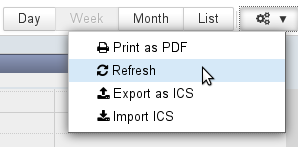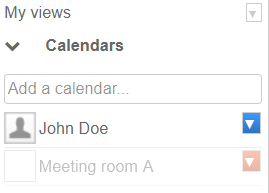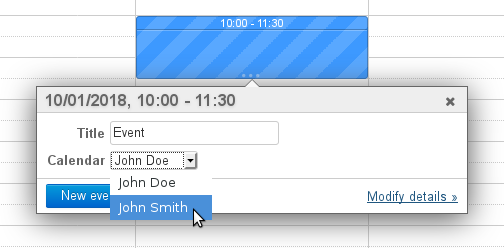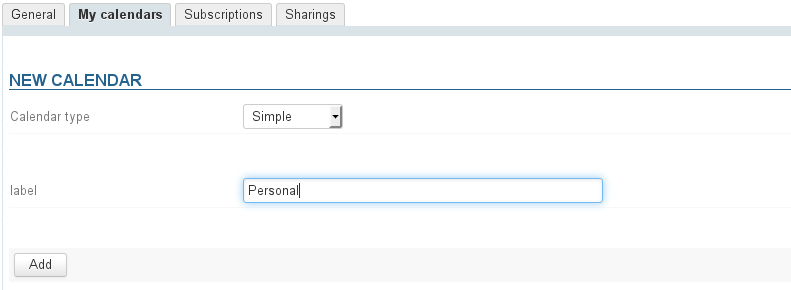Historique de la page
...
| Sv translation | ||||||||||||||||||||||||||||||||||||
|---|---|---|---|---|---|---|---|---|---|---|---|---|---|---|---|---|---|---|---|---|---|---|---|---|---|---|---|---|---|---|---|---|---|---|---|---|
| ||||||||||||||||||||||||||||||||||||
Display and navigationThe main viewThe primary default view of the BlueMind calendar is made up of:
Events are marked with icons that give you a quick view of their properties:
Selecting calendarsThe list of calendars currently displayed is shown to the left of the page, in
In BlueMind 3.5 events include more details and offer more customization options. In version 3.5.15, the BlueMind model and interface have been improved further. Clearer notification names and options help reduce errors and discrepancies between users. Recurring events have also been improved: being able to choose how changes affect events (the whole event, the whole series or further events in the series) has been rolled out to all actions performed in Calendar view. Custom meeting versionsEach participant now has their own version of a meeting. This means they can modify it (location, category, note, etc.) or set a different attendance status for an occurrence of a series of meetings: they can accept the whole series but indicate that they will not attend one or several occurrences, for instance. Organizing and participating in meetings
E.g. if John Doe wants to create a new meeting in John Smith's calendar:
Invitations and notificationsSending notificationsIn BlueMind 3.5, event information is sent by email, email notifications are therefore needed, either by the organizer to inform participants or by participants to inform the organizer of their response or change in status. From BlueMind 3.5.15, the application's interfaces have been made clearer and simpler to avoid confusion or inconsistencies between organizers' and participants' calendars. Organizers now have buttons that enables them to send or save as draft. They can also choose to notify all participants or not when they add or remove an invitee. Participants are no longer able to accept or reject an invitation without sending their response to the organizer.
To find out more, please refer to the Calendar section.
Viewing Participation StatusesAs a meeting's information is gathered by organizers only, a participant can only see other participants' statuses according to the latest version sent by the organizer (through an invitation or modification). To see up-to-date participant status, you must view the meeting in the organizer's calendar (provided they have granted you reading rights to their calendar):
About resourcesResources work the same way as users. As a result, to be able to create an event directly in the resource's calendar, users must have "Can modify my events" rights and set the resource as the organizer. User with booking rights only must create an event in their own calendar and invite the resource. In addition, version 3.5 has more advanced resource booking features which allows, in certain cases, automatic bookings or prevents overbooking. To find out more, go to the page about resources.
New behaviorDomain calendars are no longer viewed as physical entities like users or resources. They are now viewed as calendars that provide information to users, such as public holidays, company holidays, sales and marketing events (trade shows, presentations, etc.) or local events (town council meeting, exhibition, school council meeting, etc.), training days, team activities, etc. As a result, domain calendars can no longer be set as event organizers or be invited, as it used to be the case in BlueMind 3.0. New practicesThere used to be two instances domain calendars were used for:
Multiple calendarsBlueMind allows users to create and use as many personal calendars as they like and to manage how they are shared the same way they would their default calendar. Creating a new calendarTo create a new calendar:
Editing a calendarTo edit a calendar's name:
Deleting a calendarTo delete a calendar:
Sharing availabilityIn calendar preferences (see above), the "Freebusy" column allows users to select which calendar(s) will be used when other users search their availability to invite them to an event.
Once you've selected the calendar(s), fill in the "freebusy sharing" form:
Sharing can be set as:
PrintingTo print the current view, open the Tools menu at the top right of the main display area: In the "print" dialog box you can choose to print the current view as a calendar or as a list, and a preview of the selection is shown: The weekly view shown above produces the following pdf file: calendarSemaine.pdf The list view shown above produces the following pdf file: calendarListe.pdf Click "Save" to download the file.
ICS Export and ImportICS exporting and importing is available from the Tools menu at the top right of the main display area: ICS ExportThe dialog box that opens allows you to select the calendar and the events you want to export. By clicking "Export", you are offered to download or open the corresponding ICS file depending on the user's environment configuration: ICS ImportThe dialog box that opens allows you look for a file on your computer and select the calendar in which you want to import the events. You can choose from all the calendars you have write access to: ICS Synchronization |




















